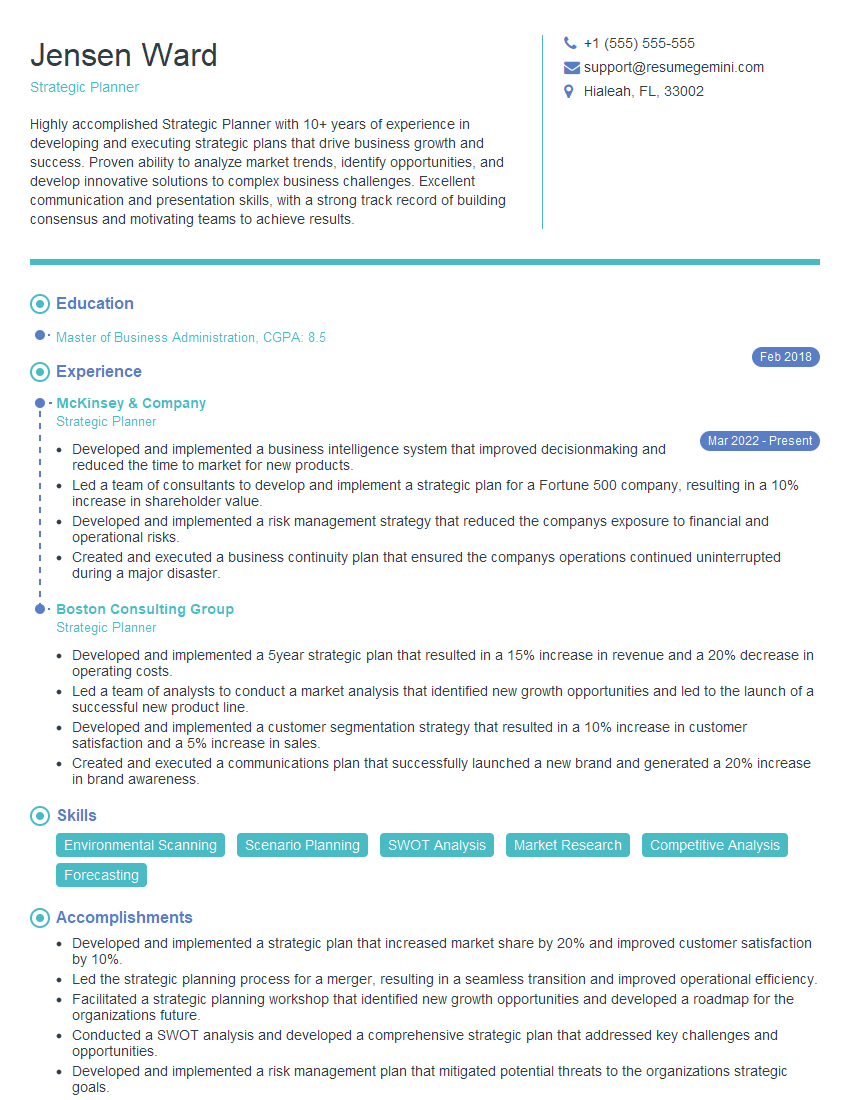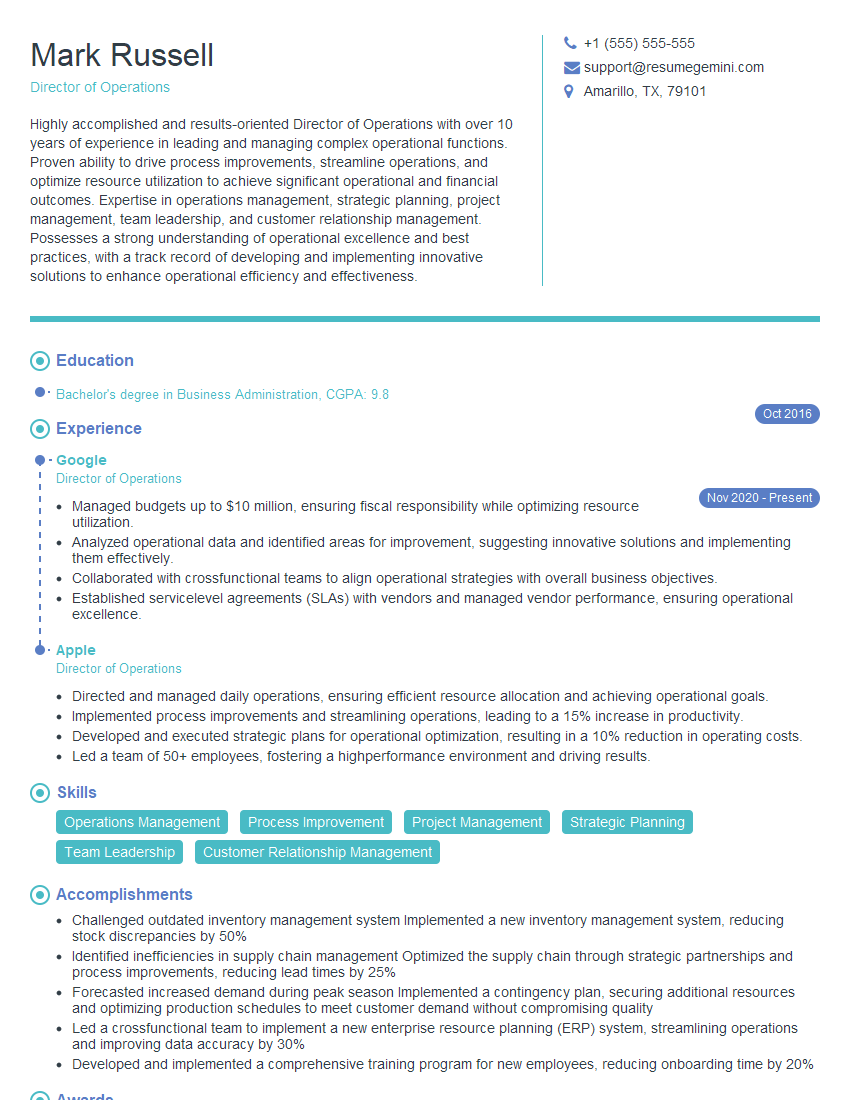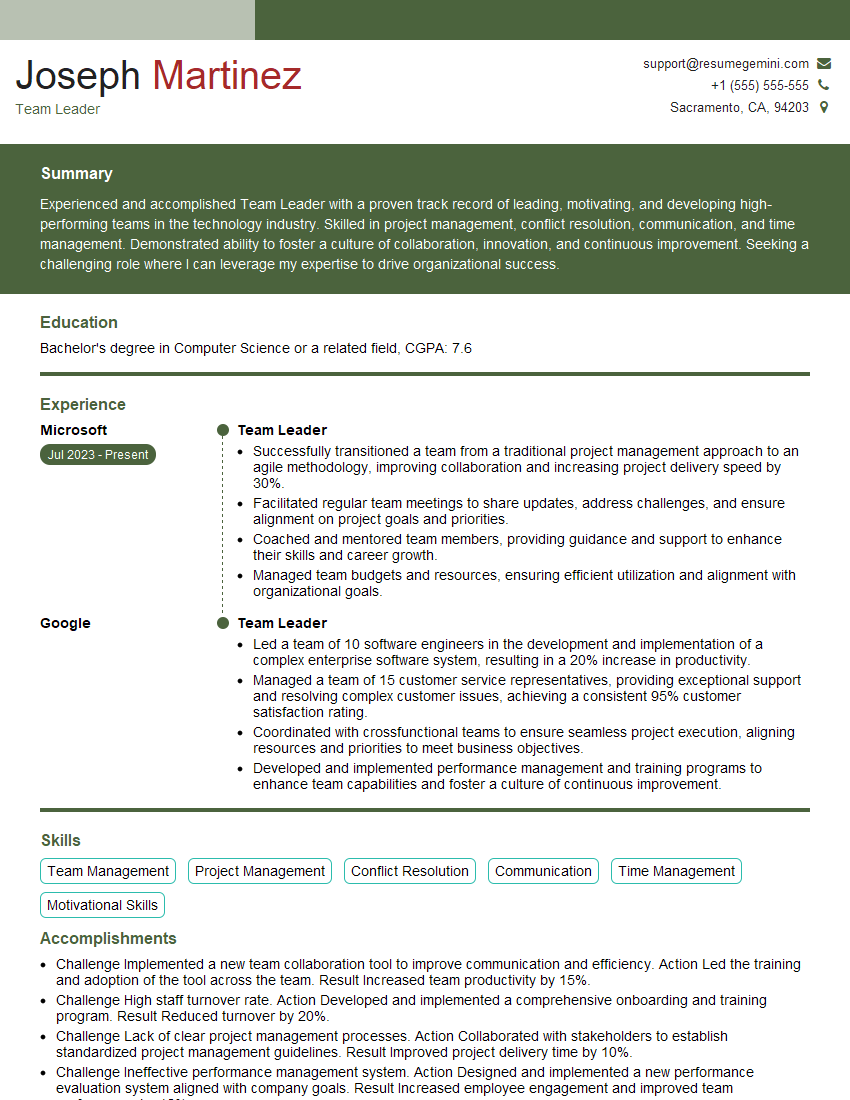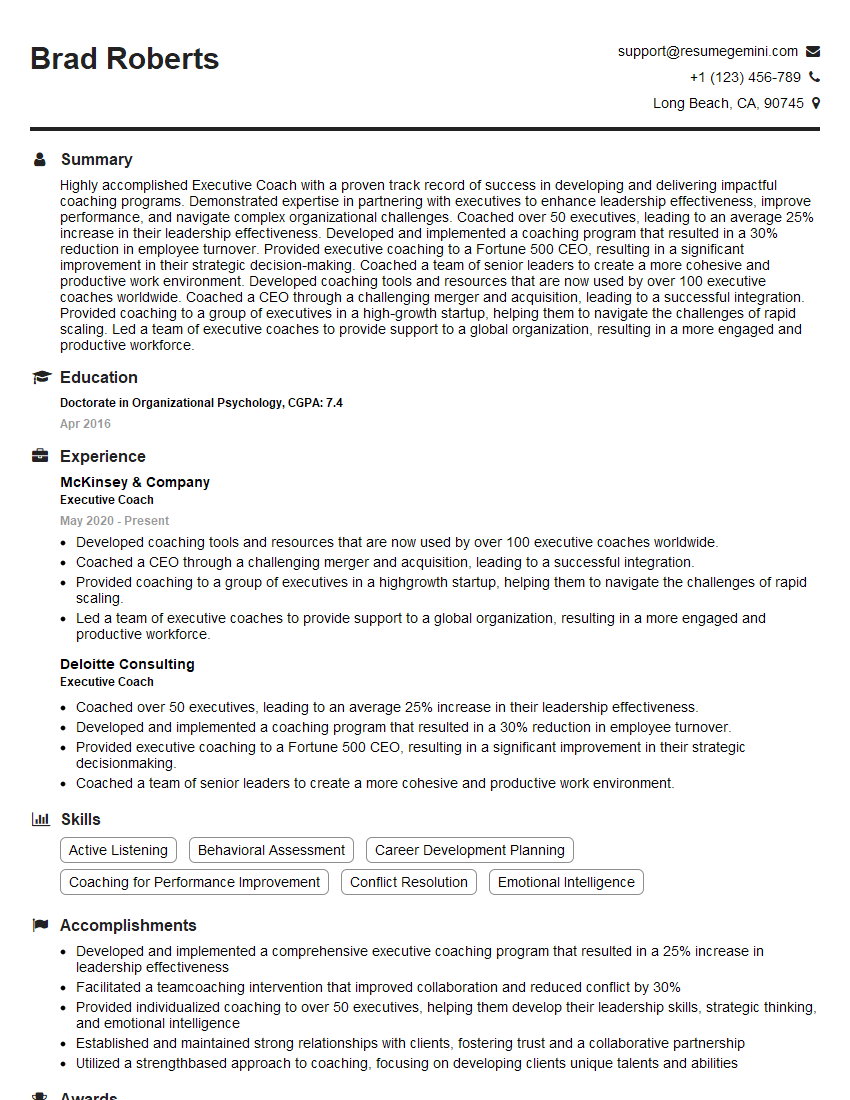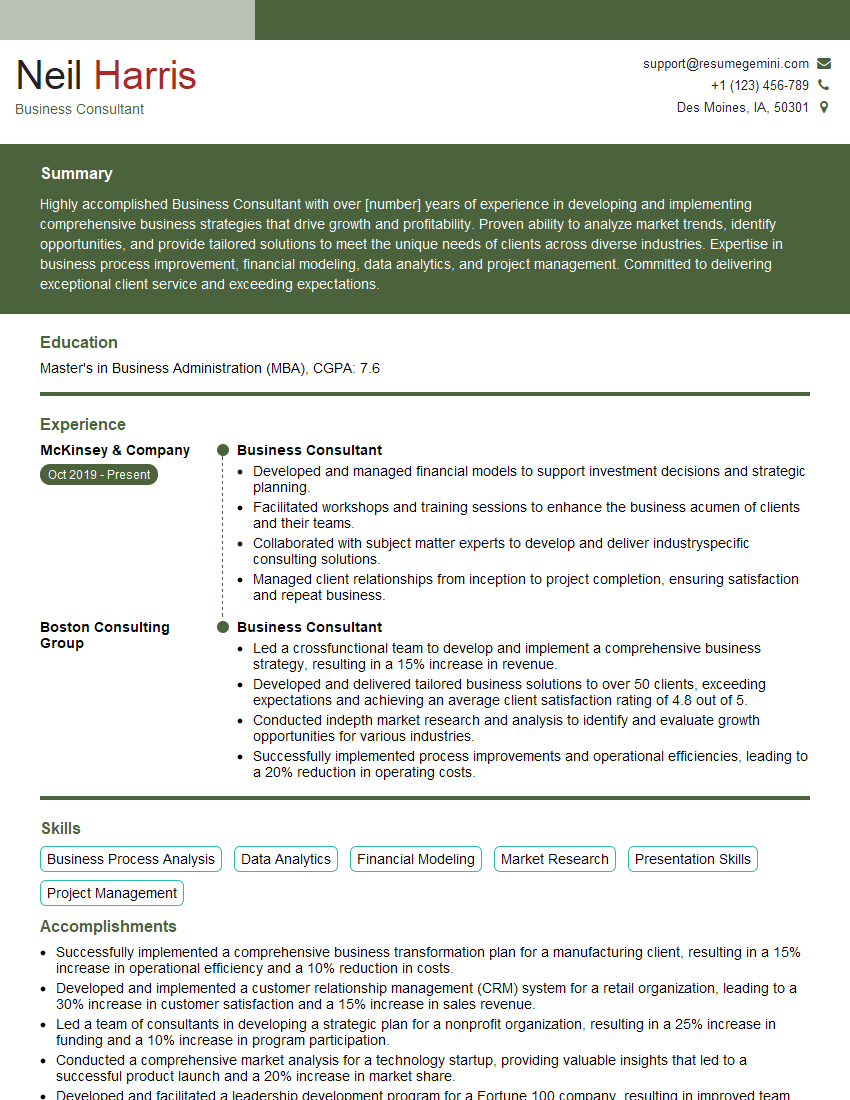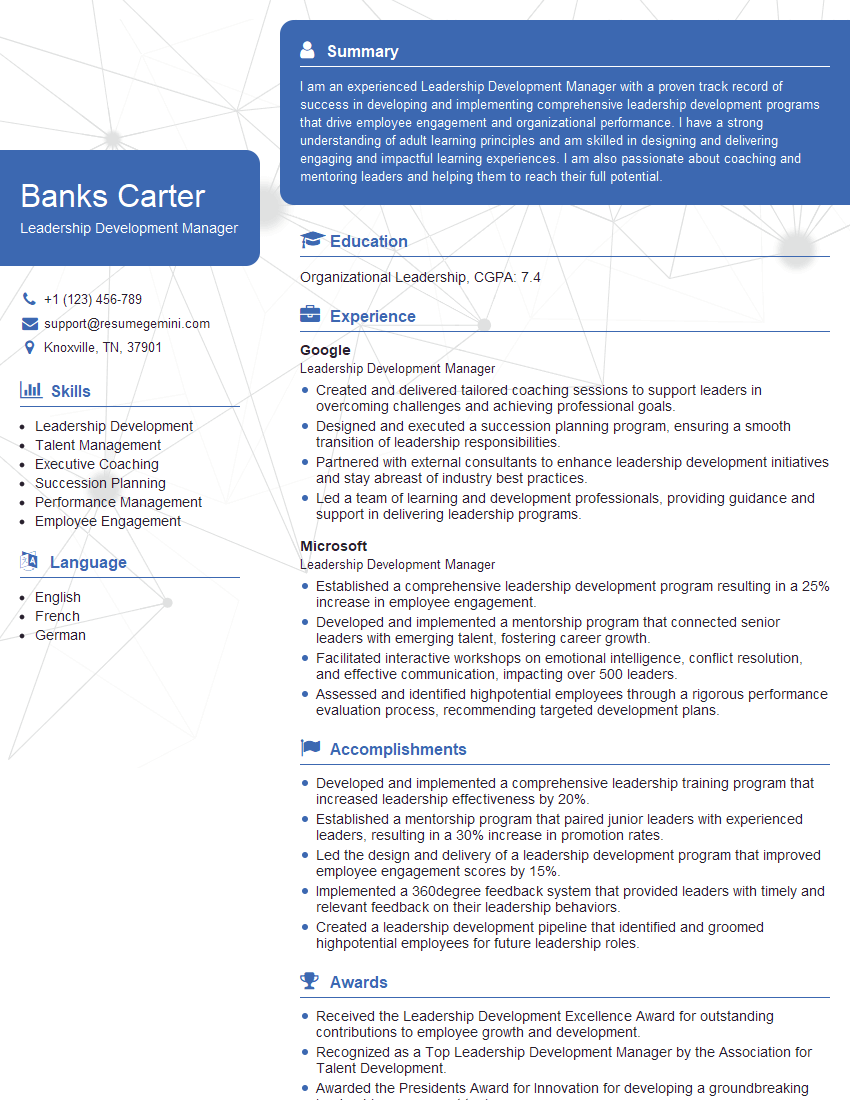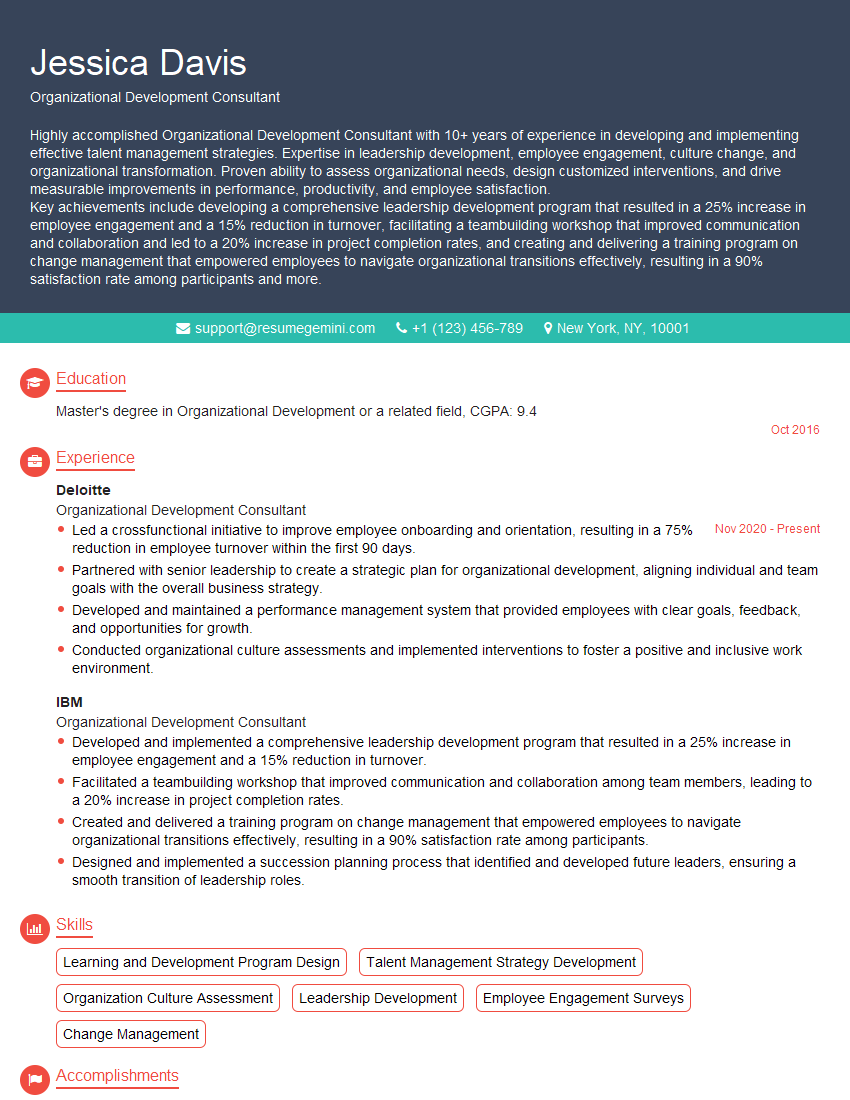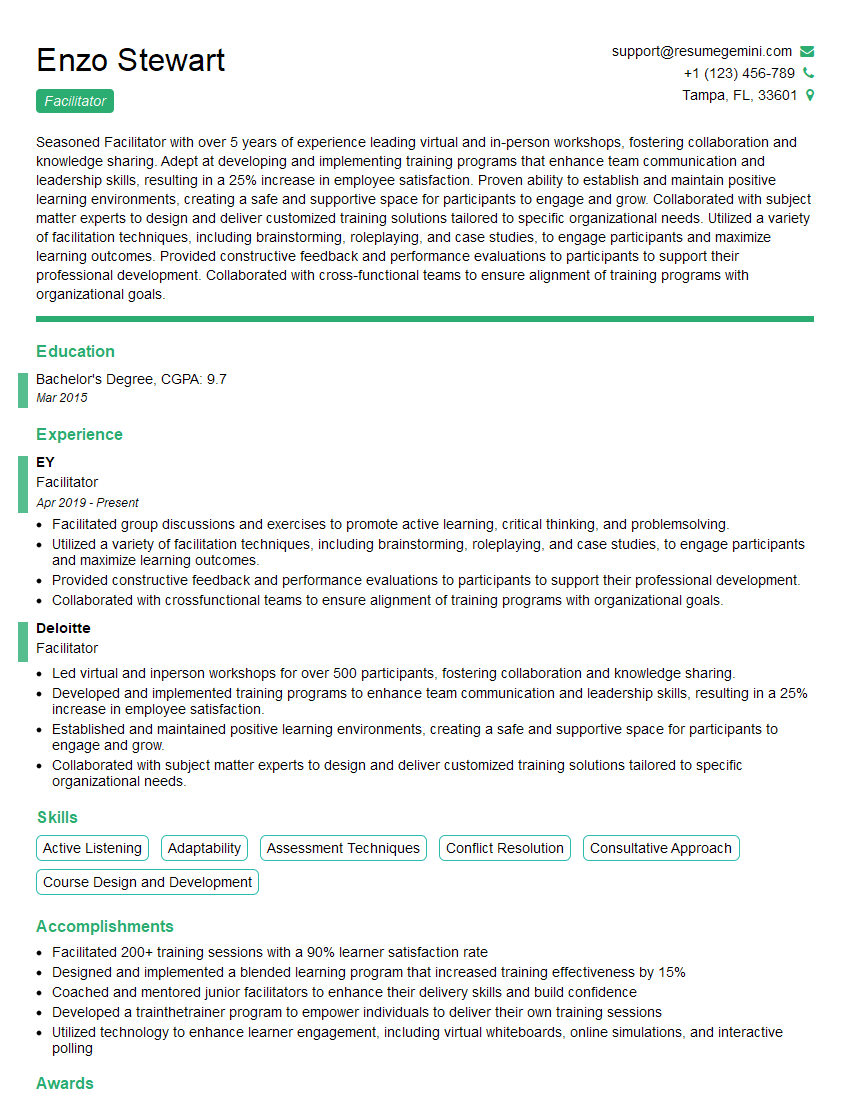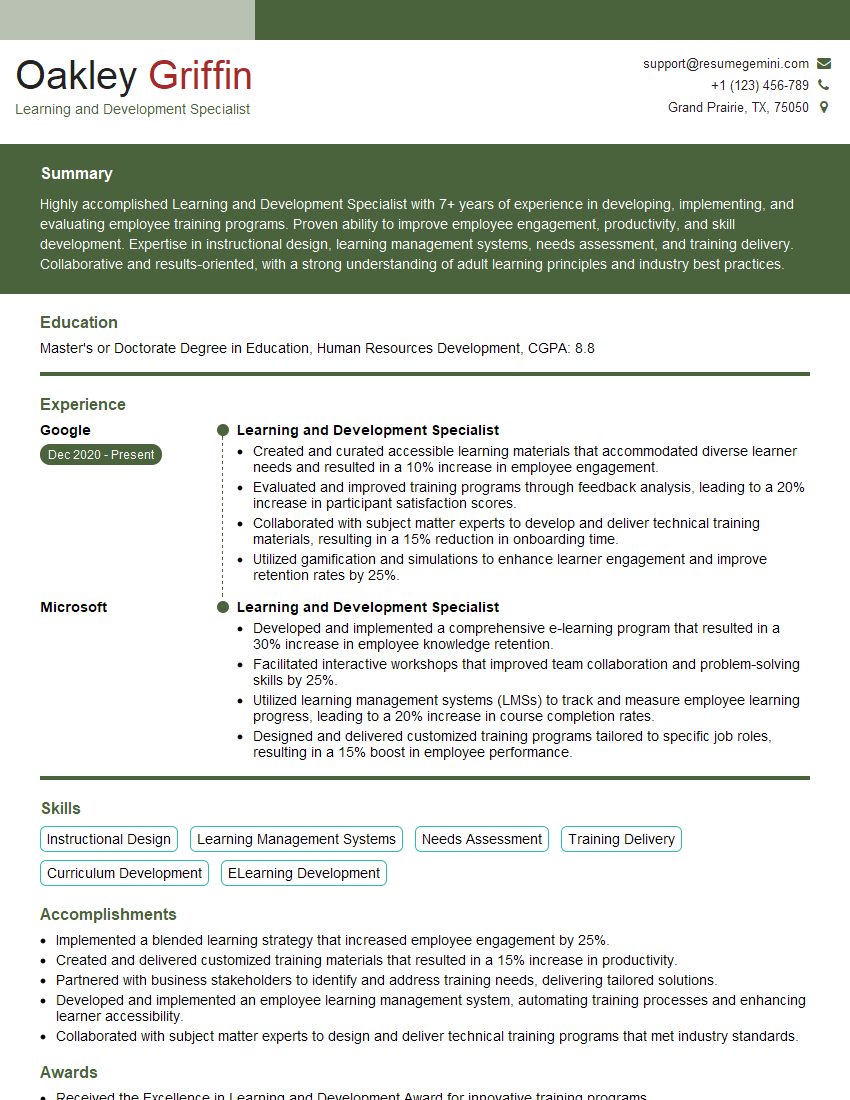Cracking a skill-specific interview, like one for Leadership Debriefing, requires understanding the nuances of the role. In this blog, we present the questions you’re most likely to encounter, along with insights into how to answer them effectively. Let’s ensure you’re ready to make a strong impression.
Questions Asked in Leadership Debriefing Interview
Q 1. Describe your process for conducting a post-project debrief.
My process for conducting a post-project debrief is structured and iterative, focusing on both celebrating successes and identifying areas for improvement. It begins with careful planning. I determine the goals of the debrief – what specific insights are we hoping to gain? Then, I choose a suitable time and location, ensuring it’s comfortable and conducive to open discussion. The debrief itself follows a clear structure:
- Setting the Stage (15 minutes): I start by acknowledging everyone’s contributions and setting a positive and respectful tone. We briefly review the project’s goals and outcomes, celebrating achievements.
- What Went Well (20 minutes): We use a structured approach, perhaps brainstorming on a whiteboard or using sticky notes, to identify the project’s successes and the factors contributing to them. Specific examples are crucial here. This fosters a sense of accomplishment and builds team morale.
- What Could Be Improved (30 minutes): This is where we address challenges and areas for improvement. I actively encourage a blame-free environment, emphasizing learning and growth. We discuss specific incidents, analyze contributing factors, and avoid generalizations. Techniques like the ‘5 Whys’ can help delve into root causes.
- Actionable Improvements (20 minutes): We collaboratively identify concrete, actionable steps to address the identified improvement areas. These steps should be SMART (Specific, Measurable, Achievable, Relevant, Time-bound). Each team member is assigned ownership of specific actions.
- Wrap-up and Next Steps (5 minutes): We summarize key takeaways, assign action items with deadlines, and confirm next steps. I ensure everyone understands their responsibilities and the overall plan for improvement.
Finally, I follow up with a written summary of the debrief, including action items and assigned owners, to ensure accountability and ongoing progress tracking.
Q 2. How do you ensure all team members contribute effectively to a debriefing session?
Ensuring all team members contribute effectively requires a multi-pronged approach. First, I create a safe and inclusive environment where everyone feels comfortable sharing their thoughts and perspectives, regardless of seniority. This includes actively listening to all contributions and showing appreciation for their input. Second, I use various techniques to encourage participation, such as:
- Round-robin discussions: Ensuring everyone gets a chance to speak.
- Anonymous feedback mechanisms: For sensitive topics.
- Structured brainstorming techniques: Like sticky notes or mind maps, to organize ideas visually.
- Pre-debrief questionnaires: To gather initial thoughts and ensure everyone comes prepared.
Finally, I actively manage the conversation, ensuring that no single voice dominates and that quiet individuals are given opportunities to contribute. I might directly ask them for their perspective or gently redirect dominating voices to ensure equitable participation.
Q 3. What techniques do you use to facilitate open and honest feedback during a debrief?
Facilitating open and honest feedback involves building trust and fostering a psychologically safe environment. This means creating a space where individuals feel comfortable expressing their thoughts and opinions without fear of judgment or reprisal. Some techniques I utilize include:
- Setting clear ground rules: Emphasizing respect, confidentiality, and a focus on learning.
- Active listening and empathy: Showing genuine interest in what others have to say and acknowledging their feelings.
- Using open-ended questions: To encourage thoughtful responses and avoid yes/no answers. Examples include: ‘What were your biggest challenges?’, ‘What surprised you during the project?’, ‘How could we have done this differently?’
- Anonymous feedback methods: Such as surveys or suggestion boxes, can be helpful for sensitive topics.
- Focusing on behaviors, not personalities: Critiquing actions rather than making personal attacks.
It’s also crucial to model vulnerability by sharing my own experiences and mistakes. This helps create a culture where honesty is valued and expected.
Q 4. How do you handle disagreements or conflicting perspectives during a debrief?
Disagreements are inevitable, and they present valuable opportunities for learning and growth. My approach focuses on constructive conflict resolution:
- Encourage respectful dialogue: I guide the discussion to focus on the issues, not the individuals involved.
- Active listening and rephrasing: Ensuring everyone feels heard and understood. I may paraphrase to clarify perspectives.
- Seeking common ground: Identifying shared goals and values to bridge differences.
- Data-driven decision making: Using project metrics and data to inform the discussion and reach objective conclusions.
- Mediation and compromise: If needed, I might facilitate a compromise that balances differing viewpoints. Sometimes, a decision needs to be made and we agree to move forward even if there isn’t complete consensus.
The goal is not necessarily to eliminate all disagreements, but to manage them constructively so that they lead to a better understanding and more effective solutions.
Q 5. How do you identify key learning points from a debriefing session?
Identifying key learning points requires careful analysis of the debriefing session. I typically utilize several methods:
- Reviewing notes and recordings: To capture all discussions and insights.
- Analyzing recurring themes: Identifying patterns and common challenges encountered.
- Categorizing feedback: Grouping similar suggestions and comments.
- Prioritizing insights based on impact: Focusing on those with the greatest potential for improvement.
- Using a structured framework: Such as a SWOT analysis (Strengths, Weaknesses, Opportunities, Threats), to organize and synthesize findings.
The key is to distill the wealth of information generated during the debrief into concise, actionable takeaways that can drive positive change.
Q 6. How do you translate debriefing insights into actionable improvements?
Translating debriefing insights into actionable improvements requires a structured approach. I focus on:
- Developing specific, measurable action items: Each item should clearly define the desired outcome, who is responsible, and the deadline for completion.
- Assigning ownership and accountability: Each action item should have a designated owner responsible for its execution.
- Establishing a tracking mechanism: To monitor progress and ensure that action items are completed on time.
- Integrating improvements into processes and procedures: To institutionalize positive changes and prevent future recurrences of problems.
- Communicating updates regularly: Keeping the team informed of progress and addressing any roadblocks.
Regular follow-up is critical to ensuring that the insights from the debrief are not just discussed but implemented and lead to tangible improvements.
Q 7. Describe a time you facilitated a debriefing that resulted in significant positive change.
During a recent software development project, the team struggled with integrating a third-party API. The initial launch was delayed and riddled with bugs. After the initial launch, I facilitated a debrief focused on identifying the root causes and implementing corrective actions. The debrief revealed several issues:
- Inadequate testing of the API integration.
- Lack of clear communication between the development and testing teams.
- Insufficient documentation of the API’s functionalities.
Following the debrief, we implemented several changes:
- Increased testing resources and implemented a more robust testing strategy.
- Introduced daily stand-up meetings between development and testing teams to enhance communication.
- Developed a comprehensive API documentation wiki.
The result was a significant improvement in the subsequent releases. Bugs were drastically reduced, integration times were faster, and overall team morale significantly improved. The project’s quality increased, demonstrating the value of a thorough debrief in achieving significant positive change.
Q 8. What are the key differences between a formal and informal debriefing?
Formal and informal debriefings differ primarily in their structure, formality, and purpose. A formal debriefing is typically a scheduled, structured meeting with a predetermined agenda, often involving multiple stakeholders and documented outcomes. Think of a post-project review with a client, a post-incident analysis after a safety breach, or a formal performance review. These often have specific reporting requirements. An informal debriefing, on the other hand, is a more casual, often impromptu conversation, perhaps a quick chat after a challenging client call or a brief discussion between team members after a complex task. The key difference lies in the level of planning, documentation, and the audience involved.
For example, a formal debrief might use a structured framework like the ‘After Action Review’ (AAR) process, while an informal debrief might simply involve a quick exchange of observations and lessons learned between two colleagues. The formality reflects the importance and complexity of the situation being debriefed.
Q 9. How do you adapt your debriefing approach based on the context and team involved?
Adapting my debriefing approach hinges on understanding the context and the team’s dynamics. Factors like the team’s size, experience level, and the sensitivity of the topic significantly influence my approach. For instance, a high-stakes situation requiring thorough analysis would necessitate a more formal, structured debrief with clearly defined objectives and documented outcomes. Conversely, a smaller, experienced team tackling a less critical task might benefit from a more informal, conversational debrief.
For a high-pressure environment, I might employ techniques like active listening and empathetic responses to create a safe space for sharing. With a newer team, I would emphasize clear communication, providing explicit guidance, and possibly using visual aids to enhance understanding. Essentially, my approach is tailored to optimize participation and maximize learning, regardless of the team’s characteristics.
Q 10. How do you ensure confidentiality during a sensitive debriefing session?
Confidentiality is paramount in sensitive debriefings. Several measures are crucial: First, select a private and secure location for the session, free from eavesdropping. Next, explicitly state the need for confidentiality at the beginning, emphasizing that information shared will remain within the group unless legally mandated otherwise. I also avoid recording the session unless explicit consent has been obtained from all participants. Finally, all materials produced during the debrief, including notes and reports, should be securely stored and access restricted to authorized individuals only.
I often use anonymization techniques when sharing aggregated data or case studies derived from the debrief to protect individual privacy while still enabling valuable insights to be shared more widely.
Q 11. What are the common pitfalls to avoid during a leadership debriefing?
Common pitfalls during leadership debriefings include a lack of structured approach, leading to unproductive discussions; focusing solely on blame rather than learning; failing to create a psychologically safe space for open and honest feedback; neglecting to actively listen and value all perspectives; and a lack of follow-through on agreed-upon action items.
For instance, placing blame on individuals instead of analyzing systemic issues can hinder future performance improvement. Similarly, not documenting key insights or action plans means the valuable learning from the debriefing is lost. Therefore, a well-structured agenda, active listening, and a commitment to implementing action items are critical for success.
Q 12. How do you measure the effectiveness of a leadership debriefing session?
Measuring the effectiveness of a leadership debrief hinges on assessing whether its objectives were met. This can be done through various means: a post-debrief survey gauging participant satisfaction and perceived learning; tracking the implementation of action items identified during the debrief; observing changes in team behavior or performance metrics related to areas addressed in the debrief; and soliciting feedback on the usefulness of the debrief from team members involved. Qualitative data (feedback, observations) alongside quantitative data (performance metrics) provide a comprehensive evaluation.
For instance, a post-debrief survey could measure improvements in teamwork, communication, or problem-solving based on the debrief’s focus. Tracking the progress of the action items directly shows the practical impact of the session.
Q 13. How do you incorporate feedback from a debriefing into future planning?
Feedback from a debrief directly informs future planning by highlighting areas for improvement, identifying potential risks, and refining strategies. Action items from the debrief are prioritized and integrated into project plans, training programs, and process improvements. For example, if a debrief reveals communication breakdowns within a team, future projects could incorporate more frequent check-ins, improved communication protocols, or additional training on collaborative tools. The debrief’s insights directly shape the adjustments needed to optimize future performance.
Regularly revisiting the action items and monitoring their progress is crucial to ensure the debrief’s impact is sustained over time. This might involve regular follow-up meetings or including relevant metrics in project reporting.
Q 14. What are some effective questioning techniques to use during a debriefing?
Effective questioning techniques during a debrief encourage reflection, promote shared understanding, and facilitate learning. Instead of focusing on closed-ended questions (yes/no answers), I utilize open-ended questions that prompt detailed responses. Some examples include:
"What were the biggest challenges we faced?""What went well, and why?""What could we have done differently?""What did we learn from this experience?""What are our key takeaways, and how can we apply these learnings in the future?"
I also use probing questions to encourage deeper reflection and avoid premature conclusions, such as "Can you tell me more about that?" or "What led you to that conclusion?". The goal is to foster a collaborative exploration of the experience, not simply a recitation of events.
Q 15. How do you manage the time effectively during a debriefing session?
Effective time management in a debriefing is crucial for maximizing learning and minimizing fatigue. It requires pre-planning and skillful facilitation. Before the session, I determine a clear objective, estimate the time needed for each agenda item, and create a structured agenda. This agenda isn’t rigid; it’s a guide. During the debrief, I stick to the allocated time for each topic, using visual timers to keep everyone aware of the time remaining. I actively manage participation, ensuring everyone contributes meaningfully without dominating the conversation. If discussion veers off-topic, I gently redirect it back to the main points. Finally, I summarize key takeaways at the end, ensuring that we conclude within the planned timeframe. For example, in a post-surgical team debrief, allocating 10 minutes to reviewing the surgical procedure, 15 minutes to discussing unexpected events, and 5 minutes for action planning keeps the session focused and efficient.
Career Expert Tips:
- Ace those interviews! Prepare effectively by reviewing the Top 50 Most Common Interview Questions on ResumeGemini.
- Navigate your job search with confidence! Explore a wide range of Career Tips on ResumeGemini. Learn about common challenges and recommendations to overcome them.
- Craft the perfect resume! Master the Art of Resume Writing with ResumeGemini’s guide. Showcase your unique qualifications and achievements effectively.
- Don’t miss out on holiday savings! Build your dream resume with ResumeGemini’s ATS optimized templates.
Q 16. How do you create a safe and psychologically secure environment for a debriefing?
Creating a safe and psychologically secure environment is paramount for a successful debrief. This involves establishing trust and psychological safety from the outset. I begin by clearly stating the purpose of the debrief, emphasizing that it’s a learning opportunity, not a blame-finding exercise. I reiterate that all contributions are valued and that honest feedback is encouraged without fear of reprisal. Active listening and non-judgmental responses from my side foster trust. I use inclusive language, ensuring everyone feels heard and respected. Furthermore, maintaining confidentiality is crucial. I clearly communicate what information will be shared and with whom. Physical environment also matters; a comfortable, private space free from distractions is essential. For instance, in a debrief following a challenging project, I would explicitly state that the goal is to learn from the challenges and improve future projects, rather than assign blame for failures. I’d also confirm that the discussion remains confidential within the team.
Q 17. Explain the importance of active listening during a debriefing.
Active listening is the cornerstone of a productive debrief. It’s not simply hearing words; it’s understanding the speaker’s perspective, emotions, and underlying message. During a debrief, active listening ensures that everyone feels heard and understood, encouraging open communication and honest feedback. I demonstrate active listening through verbal and non-verbal cues: maintaining eye contact, nodding, summarizing key points to confirm understanding, asking clarifying questions, and reflecting back the speaker’s emotions. For example, if a team member describes feeling overwhelmed during a crisis, I might respond with, “So, it sounds like you felt overwhelmed by the volume of information and the pressure of the situation.” This validates their experience and encourages further discussion. Ignoring active listening can lead to misinterpretations and missed learning opportunities.
Q 18. How do you deal with individuals who are reluctant to participate in a debrief?
Reluctance to participate can stem from various factors: fear of criticism, lack of trust, past negative experiences with debriefings, or simply discomfort with expressing opinions. My approach is empathetic and gradual. I begin by privately engaging with the reluctant individual, creating a one-on-one space for them to express their concerns without pressure. I reassure them about the debrief’s purpose – learning and improvement – and emphasize confidentiality. I might adjust my questioning style, starting with open-ended, less confrontational questions to encourage participation. If the reluctance persists, I respect their choice while ensuring their absence doesn’t hinder the overall debrief process. For instance, if someone is hesitant due to a previous negative experience, I might share a brief narrative illustrating the positive and supportive nature of this particular debrief, emphasizing its collaborative and non-judgmental focus.
Q 19. What are the benefits of using a structured debriefing framework?
A structured debriefing framework provides a consistent and repeatable process, improving efficiency and maximizing learning. It provides a roadmap, ensuring key areas are covered comprehensively. Common frameworks include the STAR method (Situation, Task, Action, Result) or a more customized approach addressing specific objectives. A structured framework helps facilitate a focused discussion, preventing tangents and ensuring key aspects aren’t overlooked. It enhances objectivity by guiding the conversation towards specific elements of performance. For instance, a structured framework using the 4Rs (Review, React, Review, Repair) can guide a debrief after a critical incident, ensuring that participants review the event, reflect on their reactions, reassess their strategies, and devise plans to address any shortcomings.
Q 20. How do you use debriefing to foster team cohesion and trust?
Debriefing is a powerful tool for fostering team cohesion and trust. By creating a space for open communication and mutual respect, debriefs facilitate shared understanding and enhance collective learning. When team members openly discuss their experiences, successes, and challenges, it fosters empathy and strengthens interpersonal relationships. Acknowledging both individual and collective contributions during a debrief strengthens team identity and promotes a shared sense of accomplishment. Addressing conflicts constructively during the debriefing process and developing solutions together helps resolve disagreements and build a stronger, more resilient team. For example, after a successful project, highlighting each team member’s contributions and the collaborative nature of the achievements enhances team morale and mutual trust. Similarly, a debrief after a failure can help build trust by demonstrating a commitment to learning from mistakes together.
Q 21. How do you identify and address individual learning needs during a debriefing?
Identifying and addressing individual learning needs requires attentive listening and observation during the debrief. By actively listening to contributions and noting patterns in individuals’ performance descriptions, I can pinpoint areas where specific support or development might be beneficial. I might notice one individual consistently struggling with a particular task or skill. This observation allows for targeted feedback, suggesting resources, coaching opportunities, or further training. Furthermore, encouraging self-reflection through thoughtful questions helps individuals identify their own areas for improvement. Following the debrief, I might create personalized development plans, assigning specific tasks or resources to address identified needs. For example, if a team member struggles with public speaking during a presentation debrief, I might suggest they enroll in a communication skills workshop or practice their presentation skills with me in a less pressured environment.
Q 22. How do you document and share the key takeaways from a debriefing?
Documenting and sharing key takeaways from a debriefing is crucial for ensuring its impact. I utilize a multi-faceted approach. Immediately following the debrief, I create concise, action-oriented notes capturing the main discussion points, decisions made, and assigned action items. These notes are then formalized into a structured document, often using a template that includes sections for:
- Summary of the event or project: A brief overview providing context.
- Key Findings/Insights: What were the successes and failures? What were the critical learning points?
- Action Items: Specific tasks, assigned owners, and deadlines.
- Recommendations: Suggestions for improvement based on the debrief.
- Next Steps: Outline the follow-up actions required.
This document is then shared with all participants via email or a collaborative platform like SharePoint or Google Docs, ensuring transparency and accountability. For sensitive information or large groups, a summary might be circulated separately. The key is clarity, conciseness, and ease of access for all involved. For example, after a challenging product launch, the debrief document clearly outlined communication breakdowns, suggesting improvements to the internal communication strategy, with specific action items assigned to relevant team members and deadlines for completion.
Q 23. Describe your experience with different debriefing models (e.g., After-Action Review).
My experience encompasses various debriefing models, including the widely used After-Action Review (AAR). AARs, which I frequently utilize, follow a structured format focusing on what happened, what was supposed to happen, what went well, what went wrong, and what we can do better next time. This framework facilitates a non-blaming, objective assessment of events. I’ve also adapted elements from other models, such as the Five Whys technique, to delve deeper into root causes of issues. For example, in a recent project with a tight deadline, we used the AAR to identify communication bottlenecks. This led to implementing a daily stand-up meeting, a change that improved collaboration and significantly reduced stress.
Beyond AARs, I incorporate elements from other models based on the situation’s complexity and urgency. Sometimes a more informal discussion works best, while other times a formal, documented review is essential. The goal remains consistent: constructive analysis leading to improved future performance.
Q 24. How do you adapt your debriefing style to different leadership levels?
Adapting my debriefing style to different leadership levels requires careful consideration of communication style, depth of detail, and decision-making authority. With junior team members, I emphasize a supportive and developmental approach, focusing on learning from mistakes and fostering growth. The debrief will be more interactive, encouraging open dialogue and questions. With senior leaders, the focus shifts toward strategic implications, focusing on high-level impact and long-term consequences. The debrief may be more concise, emphasizing key findings and strategic recommendations.
However, regardless of level, I maintain a consistent emphasis on constructive feedback, active listening, and a commitment to mutual respect. The language I use and the level of detail adjust accordingly, maintaining an appropriate level of formality and inclusivity.
Q 25. How do you ensure debriefings remain focused and productive?
Maintaining focus and productivity in debriefings requires careful planning and facilitation. Before the debrief, I clearly define the objectives, ensuring participants understand the purpose and expected outcomes. This includes outlining a clear agenda and distributing any pre-reading materials. During the debrief, I actively manage the discussion, ensuring it stays on track and addressing any tangents constructively. Timeboxing specific discussion points helps maintain momentum, and using visual aids (like a whiteboard or slides) helps keep the conversation organized and structured. Finally, I actively summarize key points throughout the discussion to reinforce understanding and prevent misunderstandings.
For instance, if a debrief starts veering into unrelated topics, I gently redirect the conversation back to the pre-defined agenda, highlighting the importance of covering all key aspects within the allotted time. This structured approach ensures a productive and efficient session.
Q 26. How do you integrate debriefing into your overall leadership approach?
Debriefing is an integral part of my leadership approach, acting as a continuous feedback loop for improvement. It’s not a standalone activity but a fundamental element of my leadership philosophy. I view it as a proactive mechanism to identify areas for development, both at the individual and team levels. I integrate debriefs into various aspects of project management, incorporating them after key milestones, major events, or at the conclusion of a project. The insights gained inform future strategies, processes, and team development initiatives.
For example, following a successful project, a debrief allows us to identify best practices that can be replicated in future endeavors. Similarly, after a less successful project, the debrief fosters a culture of learning and improvement, ensuring similar mistakes are avoided in the future.
Q 27. What are the ethical considerations when conducting leadership debriefings?
Ethical considerations are paramount in conducting leadership debriefings. Maintaining confidentiality is crucial, particularly when sensitive information is discussed. Ensuring a safe and respectful environment where participants feel comfortable sharing their honest perspectives without fear of retribution is vital. This requires active listening, empathy, and a commitment to fair and objective feedback. Furthermore, participants’ contributions should be acknowledged and valued, regardless of their position or seniority.
In situations involving potentially sensitive or legally relevant information, I ensure participants are aware of any confidentiality protocols or legal implications before the debrief commences. I also strive to create a culture of psychological safety, where team members feel comfortable openly sharing their experiences without fear of negative consequences.
Q 28. How do you ensure that action items from a debrief are actually implemented?
Ensuring action items from a debrief are implemented requires a systematic follow-up process. After the debrief, I create a clear action plan, assigning owners and deadlines for each item. These are then tracked using project management tools or spreadsheets. I schedule regular follow-up meetings to check progress and address any roadblocks. Furthermore, I actively support those responsible for implementing the action items, providing guidance, resources, and removing any obstacles that might impede their progress.
For example, if an action item involves securing additional budget, I would actively assist in preparing the necessary documentation and advocating for the request. This proactive approach ensures accountability and increases the likelihood that agreed-upon changes are implemented, maximizing the overall value and impact of the debrief.
Key Topics to Learn for Leadership Debriefing Interview
- Defining Effective Debriefing: Understanding the purpose and goals of a leadership debrief; differentiating between feedback, coaching, and debriefing.
- Structured Debriefing Techniques: Applying proven frameworks and models to ensure comprehensive and actionable debriefs; examples include the STAR method and After-Action Reviews (AAR).
- Active Listening & Questioning: Mastering techniques for eliciting insightful information from team members; understanding the importance of open-ended questions and empathetic listening.
- Identifying Key Learning Points: Discerning critical successes and failures; translating observations into actionable insights for future performance improvement.
- Facilitating Constructive Dialogue: Creating a safe and inclusive environment for honest feedback; managing conflict constructively and fostering a culture of continuous learning.
- Action Planning & Follow-Up: Developing concrete action plans based on debrief insights; establishing clear accountability and monitoring progress towards goals.
- Adapting Debriefing Styles: Tailoring the approach based on team dynamics, context, and the specific situation; understanding how to adapt your communication style for different personalities.
- Measuring the Impact of Debriefing: Assessing the effectiveness of debrief sessions; identifying metrics to track improvements in team performance and individual development.
Next Steps
Mastering leadership debriefing is crucial for career advancement. It demonstrates your ability to learn from experiences, foster team growth, and drive continuous improvement – highly valued qualities in any leadership role. To significantly increase your chances of landing your dream job, focus on crafting a compelling, ATS-friendly resume that showcases your relevant skills and experience. We highly recommend using ResumeGemini to build a professional and impactful resume tailored to highlight your expertise in leadership debriefing. Examples of resumes specifically designed for Leadership Debriefing roles are available to help you get started.
Explore more articles
Users Rating of Our Blogs
Share Your Experience
We value your feedback! Please rate our content and share your thoughts (optional).
What Readers Say About Our Blog
good

